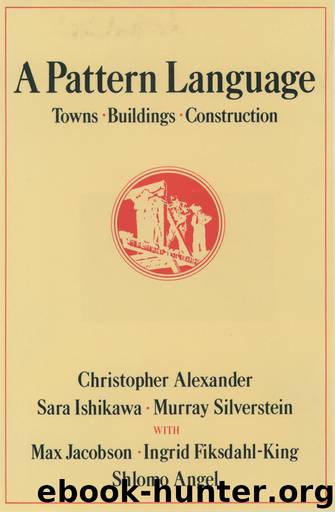A Pattern Language by Christopher Alexander

Author:Christopher Alexander
Language: eng
Format: epub
Publisher: Oxford University Press
Published: 2015-10-26T16:00:00+00:00
Placing the main entrance (or main entrances) is perhaps the single most important step you take during the evolution of a building plan.
The position of main entrances controls the layout of the building. It controls movement to and from the building, and all the other decisions about layout flow from this decision. When the entrances are placed correctly, the layout of the building unfolds naturally and simply; when the entrances are badly placed, the rest of the building never seems quite right. It is therefore vital that the position of the main entrance (or entrances) be made early and correctly.
The functional problem which guides the placing of main entrances is simple. The entrance must be placed in such a way that people who approach the bulding see the entrance or some hint of where the entrance is, as soon as they see the building itself. This makes it possible for them to orient their movements toward the entrance as soon as they start moving toward the building, without having to change direction or change their plan of how they will approach the building.
The functional problem is rather obvious, but it is hard to overestimate the contribution it makes to a good building. We have had the experience over and again, that until this question is settled and an appropriate position chosen, a project is at a stalemate. And conversely, once the main entrances have been located and they can be felt to be in the right position, then other decisions begin to come naturally. This is true for single houses, house clusters, small public buildings, large complexes of public buildings. Apparently, the pattern is basic, no matter the scale of the building.
Let us look into the functional question in more detail. Everyone finds it annoying to search around a building, or a precinct of buildings, looking for the proper entrance. When you know just where the entrance is, you don’t have to bother thinking about it. It’s automatic—you walk in, thinking about whatever’s on your mind, looking at whatever catches your eye—you are not forced to pay attention to the environment simply to get around. Yet the entrances to many buildings are hard to find; they are not “automatic” in this sense.
There are two steps to solving the problem. First, the main entrances must be placed correctly. Second, they must be shaped so they are clearly visible.
1. Position
Consciously or unconsciously, a person walking works out his path some distance ahead, so as to take the shortest path. (See Tyrus Porter, A Study of Path Choosing Behavior, thesis, University of California, Berkeley, 1964). If the entrance is not visible when the building itself becomes visible, he cannot work out his path. To be able to work out his path, he must be able to see the entrance early, as soon as he sees the building.
And for other reasons too, the entrance needs to be the first thing that you come to. If you have to walk a long distance along the
Download
This site does not store any files on its server. We only index and link to content provided by other sites. Please contact the content providers to delete copyright contents if any and email us, we'll remove relevant links or contents immediately.
Kathy Andrews Collection by Kathy Andrews(11768)
The remains of the day by Kazuo Ishiguro(8897)
Paper Towns by Green John(5142)
Spare by Prince Harry The Duke of Sussex(5142)
The Body: A Guide for Occupants by Bill Bryson(5034)
Industrial Automation from Scratch: A hands-on guide to using sensors, actuators, PLCs, HMIs, and SCADA to automate industrial processes by Olushola Akande(5027)
Machine Learning at Scale with H2O by Gregory Keys | David Whiting(4262)
Be in a Treehouse by Pete Nelson(4002)
Never by Ken Follett(3885)
Harry Potter and the Goblet Of Fire by J.K. Rowling(3810)
Goodbye Paradise(3767)
Into Thin Air by Jon Krakauer(3350)
The Remains of the Day by Kazuo Ishiguro(3349)
Fairy Tale by Stephen King(3311)
The Cellar by Natasha Preston(3299)
The Genius of Japanese Carpentry by Azby Brown(3256)
120 Days of Sodom by Marquis de Sade(3229)
The Man Who Died Twice by Richard Osman(3043)
Drawing Shortcuts: Developing Quick Drawing Skills Using Today's Technology by Leggitt Jim(3040)
